Creating a bedroom that captures your child’s imagination isn’t just about pretty decorations—it’s about crafting a personal universe where dreams take flight and memories are made. As children grow, their bedroom becomes their sanctuary, a place where they can express themselves, play freely, and find comfort at the end of each day.
Whether you’re designing a space for a toddler, school-aged child, or sharing siblings, these bedroom ideas kids will love can transform an ordinary room into an extraordinary haven. Let’s explore how to create spaces that nurture creativity, organization, and comfort while reflecting your child’s unique personality.
1. Themed Wonderlands: From Cosmic Explorers to Jungle Adventures
Themed bedrooms create immersive environments that stimulate imagination and storytelling. When a child steps into a room that transports them to another world—whether it’s outer space, a lush jungle, or an underwater kingdom—their creativity flourishes naturally. This environment encourages role-playing and exploration, building cognitive skills through daily play.
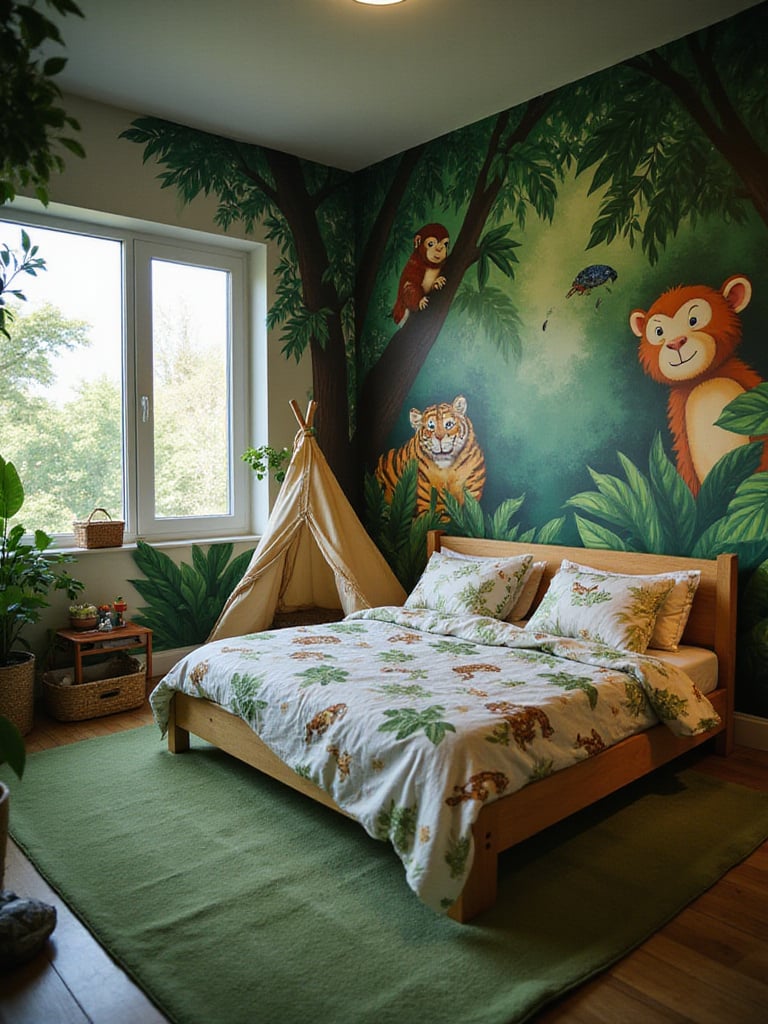
The beauty of themed bedroom ideas kids love is how they can reflect your child’s passions while creating a comforting personal space. Rather than generic decorations, choose elements that spark genuine curiosity. A constellation projector transforms a ceiling into a galaxy, while botanical wall decals can create a forest feel without permanent commitment.
- Install a glow-in-the-dark star ceiling for budding astronomers
- Create a reading nook inside a play tent for jungle explorers
- Use removable ocean-themed wall decals for flexibility as interests change
The magic of themed spaces isn’t just in how they look, but in how they make children feel—like the heroes of their own adventures. As their imaginations soar in these personalized environments, let’s consider how color can further enhance the emotional landscape of their space.
2. Color Psychology: Vibrant Palettes for Energetic Play Spaces
Color does more than please the eye—it speaks directly to our emotions and energy levels. In bedroom ideas kids respond to, color selection becomes a powerful tool for creating the right atmosphere. Sunny yellows stimulate creativity and optimism, while vibrant oranges bring warmth and enthusiasm. Cheerful greens connect children to nature, offering a balance of energy and calm.
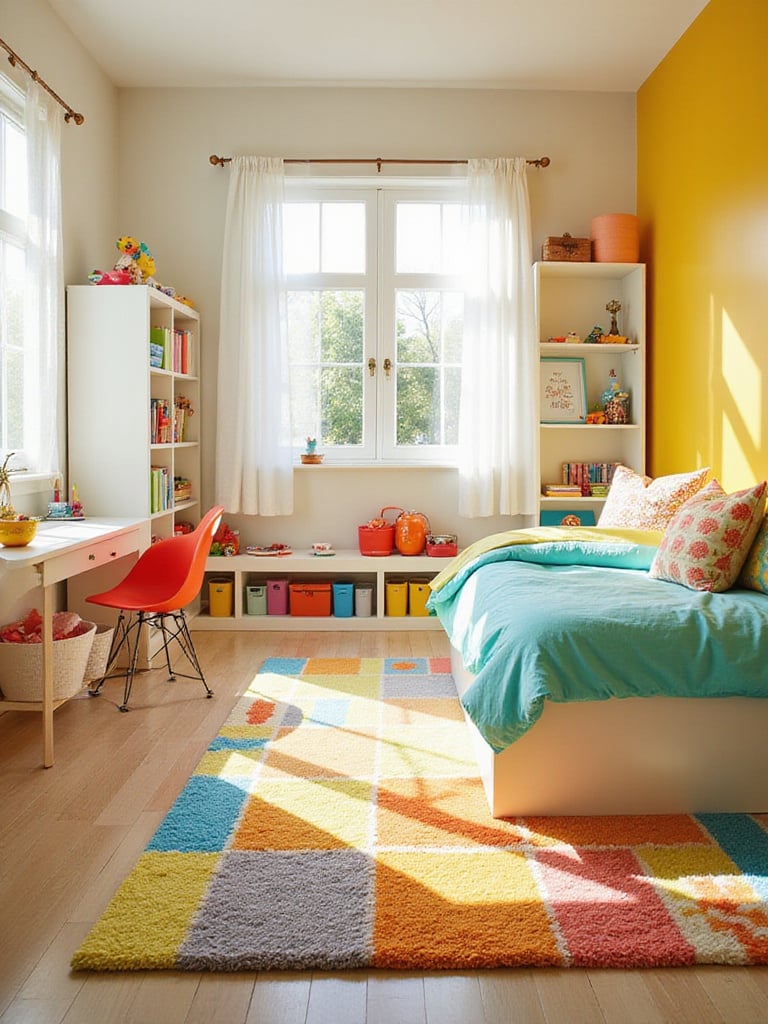
The impact of color choices extends beyond aesthetics to influence how children feel and function in their space. While bright, warm hues can energize a play area, it’s important to balance these intense shades with neutral zones, especially around sleeping areas. This creates visual “breathing room” and prevents overstimulation, particularly for children sensitive to sensory input.
- Paint one accent wall in a bold color like electric blue or sunshine yellow
- Use colorful textiles like rugs, pillows, and curtains that can be easily changed
- Consider color-blocking techniques to define different functional zones
The thoughtful application of color lays the foundation for a vibrant, cheerful space. Now, let’s explore how smart storage solutions can maintain this beautiful environment while managing the inevitable accumulation of toys and treasures.
3. Storage Solutions: Clever Systems That Grow With Your Child
In bedroom ideas kids actually use, smart storage isn’t an afterthought—it’s essential infrastructure. Children naturally collect a multitude of belongings, from stuffed animals and art supplies to books and seasonal clothing. Without effective storage systems, these treasures quickly transform into overwhelming clutter that inhibits both play and relaxation.

The most successful storage solutions combine accessibility with visual appeal, making organization intuitive for children. Built-in wall units maximize vertical space while providing dedicated homes for different categories of items. Under-bed drawers utilize otherwise wasted space, and decorative baskets add texture while containing smaller objects. These systems do more than create order—they teach children valuable organizational skills they’ll carry throughout life.
- Design a built-in wall unit combining open shelving, closed cabinets, and perhaps a fold-down desk
- Use clear, labeled bins for toys so children can easily find and return items
- Incorporate storage that adapts as needs change—modular systems that can be reconfigured
Beyond just containing possessions, thoughtful storage creates the foundation for a functional, peaceful environment. The breathing room created by good organization sets the stage for the centerpiece of any bedroom—the bed itself, which we’ll explore next.
4. Dream-Worthy Beds: Sleep Spaces That Spark Imagination
The bed anchors the entire bedroom design, and innovative options go far beyond standard frames. For bedroom ideas kids find truly magical, consider how the sleeping space can double as a play structure or maximize room functionality. Bunk beds transform sleeping into an adventure while efficiently using vertical space—perfect for siblings sharing rooms or frequent sleepovers.
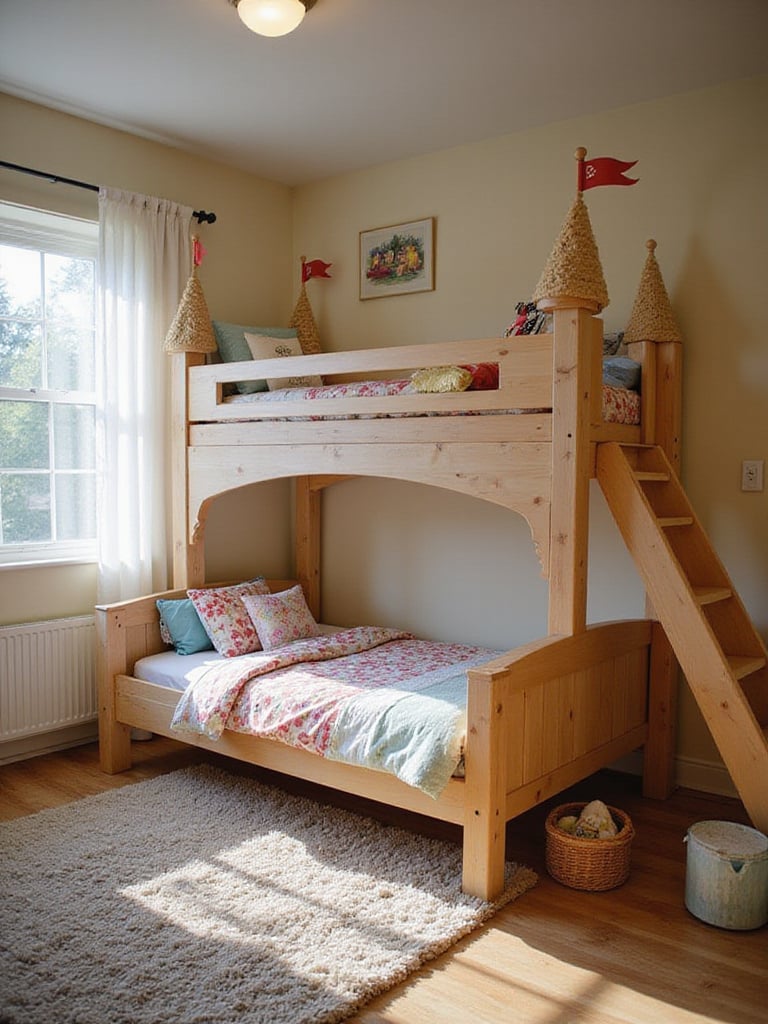
Loft beds elevate the sleeping area, freeing valuable floor space beneath for desks, play areas, or additional storage. For the ultimate in imagination-sparking design, themed beds—whether shaped like castles, race cars, or pirate ships—turn bedtime from a chore into an adventure kids eagerly anticipate. These special beds become the heart of the room’s identity and often children’s favorite feature.
- Integrate a slide into a loft bed for a playful morning routine
- Consider beds with built-in storage drawers to maximize functionality
- For themed beds, choose designs with timeless appeal that won’t quickly be outgrown
The right bed creates both a practical sleeping space and a focal point that anchors the room’s design. With this foundation established, let’s look at how to carve out dedicated zones that support different activities within the bedroom.
5. Play Zone Magic: Dedicated Areas for Imagination and Creativity
The running thread through successful bedroom ideas kids truly use is thoughtful zoning. Designating a specific play area within the bedroom creates structure that children intuitively understand—this is where building, creating, and imagining happen. This boundary-setting helps children focus during playtime and makes the inevitable cleanup more manageable.
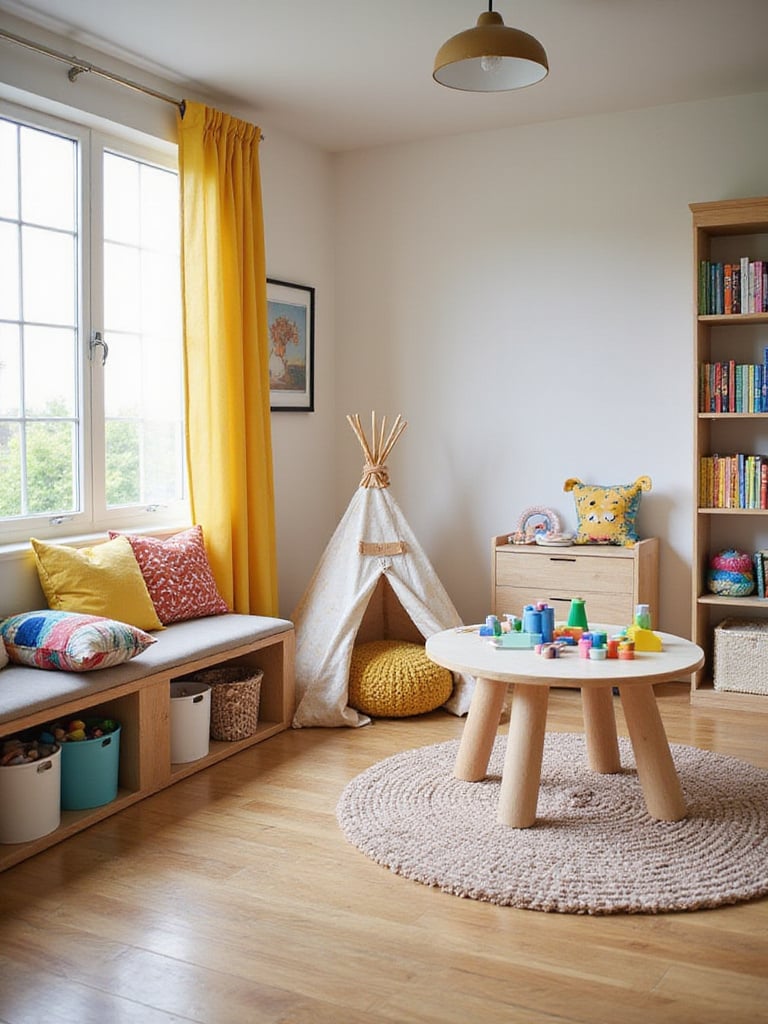
A well-designed play zone might feature a soft, washable rug defining the area, low shelving keeping favorite toys accessible, and perhaps a small table for crafts or building. The beauty of dedicated play spaces is how they encourage independent exploration while containing the creative chaos that comes with childhood. For parents, this zoning makes daily maintenance simpler, as toys have a clear “home” to return to.
- Mount a magnetic board or chalkboard at child-height for artistic expression
- Create a sensory corner with different textures and manipulative toys
- Use colorful floor cushions to define a flexible play space that can evolve
The thoughtful creation of play zones honors children’s need for both structure and creative freedom. As we design spaces that celebrate their imaginative worlds, let’s also consider how personalization makes these rooms truly their own.
6. Personal Touches: Making the Space Uniquely Theirs
Among all bedroom ideas kids connect with most deeply, personalization stands out as essential. When children see their name, artwork, and photos prominently displayed, they receive a powerful message about their place in the world. These personal elements transform a generic room into a space that celebrates their identity and interests.
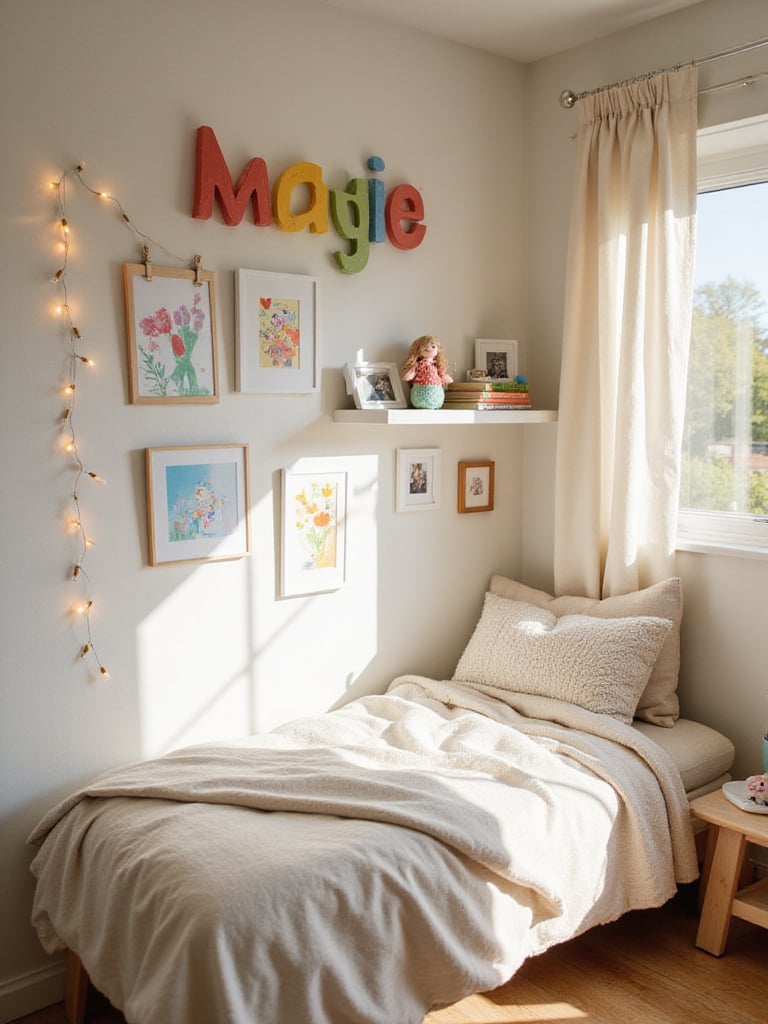
Personalization goes beyond aesthetics to nurture a child’s developing sense of self. A gallery wall displaying their artistic creations communicates that their expression is valued. Photos of family adventures or friends create a sense of connection and belonging. Custom name signs or monogrammed items reinforce that this space is truly theirs—a sanctuary designed with them in mind.
- Create a rotating art display using clipboards or frames with easy-change capabilities
- Install a growth chart that becomes a cherished record of childhood
- Display collections (rocks, shells, figurines) on dedicated shelves with proper lighting
These personal elements make the room a reflection of the child who lives there. As we consider how to highlight these special touches, the right lighting becomes crucial for creating atmosphere and functionality.
7. Layered Lighting: Creating Atmosphere and Functionality
In thoughtfully designed bedroom ideas kids can grow with, lighting serves multiple crucial functions. Layered lighting—combining ambient, task, and accent sources—creates flexibility for different activities and times of day. Bright overhead lights support active play, while focused desk lamps facilitate homework, and soft accent lighting creates a calming bedtime environment.

The emotional impact of lighting cannot be overstated. String lights draped across a canopy or fairy lights in a reading nook create magical, cozy spaces that feel special. Playful fixtures shaped like clouds, stars, or favorite characters add personality while providing necessary illumination. Smart lighting with dimmers or color-changing capabilities can transform the room’s atmosphere instantly, supporting different activities and moods.
- Install warm-toned fairy lights around bed frames or canopies for a magical glow
- Use clip-on book lights for bedtime reading without disturbing sleep transitions
- Consider projection lights that display stars, underwater scenes, or other calming patterns
The right lighting transforms the room throughout the day, from energetic play space to peaceful sleep sanctuary. With this atmospheric foundation, let’s consider how the floor beneath can add both comfort and definition to the space.
8. Floor Comfort: Rugs That Define Spaces and Protect Little Feet
In practical bedroom ideas kids benefit from daily, the right rug does far more than decorate—it creates a soft landing pad for play, reading, and everyday activities. Children naturally gravitate toward floor play, making a comfortable surface essential. Plush rugs provide warmth underfoot, absorb sound, and create visual boundaries that help define the room’s different functional areas.

Beyond comfort, rugs contribute significantly to room safety and atmosphere. A non-slip rug pad prevents dangerous slipping, while the rug itself cushions potential falls during active play. From a design perspective, rugs tie together color schemes and themes, acting as artistic foundations that can be updated more easily than furniture or paint as children’s tastes evolve.
- Use a large, soft shag rug to create a cozy central play zone
- Consider washable rugs for easy maintenance in high-traffic areas
- Layer smaller accent rugs to define reading corners or desk areas
With the floor now soft and inviting, our attention turns upward to the windows, where treatments balance practical needs with whimsical design elements.
9. Window Magic: Functional Treatments With Playful Personality
Window treatments in bedroom ideas kids truly benefit from serve multiple essential functions beyond mere decoration. Quality blackout curtains create the darkness necessary for healthy sleep, especially during summer months when bedtime arrives well before sunset. This light control is crucial for establishing consistent sleep patterns and making nap times more successful.

The best window treatments for children’s rooms balance practicality with personality. Curtains featuring favorite colors or subtle patterns become statement pieces that tie together the room’s design elements. Cordless blinds or secured curtain pulls ensure safety for curious little ones, while insulating properties help maintain comfortable temperatures year-round, contributing to better sleep and energy efficiency.
- Choose blackout curtains with glow-in-the-dark star patterns for nighttime magic
- Consider double-layer treatments: functional blackout blinds paired with decorative curtains
- Use window treatments to reinforce the room’s color scheme or theme
With windows beautifully dressed, we turn our attention to the walls themselves—blank canvases waiting to be transformed into spectacular focal points.
10. Wall Transformations: From Blank Canvas to Spectacular Statements
Walls occupy the largest visual space in bedroom ideas kids find captivating, making them perfect canvases for creative expression. Wallpaper transforms an ordinary wall into an immersive environment—whether featuring delicate patterns, bold graphics, or entire scenes like forests or cityscapes. Modern peel-and-stick options offer flexibility as children’s tastes evolve.

Murals create dramatic focal points that establish or reinforce the room’s theme. A hand-painted mural becomes a treasured feature that can tell a story or transport children to another world. For more flexibility, wall decals offer the impact of custom artwork without the commitment, allowing for easy updates as interests change. These larger wall treatments set the stage for the room’s overall feel while expressing your child’s personality.
- Create an accent wall using removable wallpaper in a bold pattern or scene
- Apply a world map mural for educational value and visual interest
- Use a collection of coordinating decals to create a custom scene that can evolve
These wall transformations set a dramatic backdrop for daily life. With the environment established, let’s create a dedicated space for learning and creativity within this personal sanctuary.
11. Study Spaces: Fostering Focus and Creative Thinking
In comprehensive bedroom ideas kids can truly grow with, a thoughtfully designed study area becomes increasingly important as they progress through school. This dedicated zone signals to children that focused work and creative thinking have their own special place, distinct from areas for play or rest. This separation helps children mentally transition between activities and develop healthy work habits.

The most successful study spaces combine functionality with inspiration. Position desks near natural light when possible, as this improves concentration and reduces eye strain. Ensure proper task lighting for cloudy days or evening homework sessions. Incorporate vertical storage with shelves or bulletin boards to keep supplies organized and display inspirational elements. The goal is creating a space that feels both efficient and personally motivating—somewhere children genuinely want to spend time learning and creating.
- Create a “command center” with calendar, bulletin board, and supply organizers
- Choose an appropriately-sized desk and ergonomic chair that can adjust as they grow
- Include personal touches like framed artwork or inspirational quotes in the study zone
A well-designed study area supports academic success while nurturing creativity. As we focus on organization throughout the room, let’s explore systems that make tidying intuitive and even enjoyable for children.
12. Organization Systems: Making Tidiness Simple and Sustainable
The most practical bedroom ideas kids will actually maintain incorporate intuitive organization systems that make tidying up approachable rather than overwhelming. Labeled bins transform cleanup from a generic “clean your room” to specific, manageable tasks: “books go in the blue bin, building blocks in the green bin.” This clarity makes organization accessible even for younger children.

Effective systems work with children’s natural tendencies rather than against them. Open bins allow for quick cleanup without removing lids, while clear containers make contents visible without reading labels. Drawer dividers prevent small items from becoming jumbled messes, and rotating toy systems (keeping some toys in storage and swapping periodically) reduce overwhelm while making old toys feel new again. These thoughtful approaches reduce parent-child conflicts over tidiness while teaching valuable life skills.
- Use picture labels for pre-readers and text labels for older children
- Implement a “one in, one out” system for managing toy collections
- Create seasonal rotation systems for clothes and toys to reduce clutter
Smart organization creates the foundation for a peaceful, functional environment. Now, let’s explore furniture that maximizes functionality through adaptable, multi-purpose design.
13. Multi-Functional Furniture: Space-Saving Solutions With Style
In the realm of practical bedroom ideas kids can use for years, multi-functional furniture stands out as both space-efficient and budget-friendly. These clever pieces serve multiple purposes simultaneously, making them particularly valuable in smaller bedrooms where every square foot matters. A storage bench provides seating and toy containment, while a loft bed creates an entire room beneath the sleeping space.

The long-term value of multi-functional furniture becomes apparent as children grow. Convertible cribs that transform into toddler beds and eventually full-sized beds eliminate the need for multiple purchases. Modular shelving systems can be reconfigured as storage needs evolve. Desks with adjustable heights accommodate growing bodies. These adaptable pieces represent thoughtful investments that serve changing needs throughout childhood and often into the teen years.
- Consider a loft bed with integrated desk, shelving, and wardrobe underneath
- Look for ottomans or benches with hidden storage for quick cleanup
- Invest in extendable tables that can grow from art station to homework desk
These hardworking furniture pieces create more usable space within the same square footage. With the practical elements addressed, let’s create a special retreat where children can relax and recharge.
14. Cozy Retreats: Personal Havens for Relaxation and Daydreaming
Among the most beloved bedroom ideas kids consistently gravitate toward are cozy, defined retreats within the larger space. These snug nooks serve as personal havens where children can curl up with a book, process emotions, or simply daydream. In our often overstimulated world, these quiet zones provide essential opportunities for children to decompress and self-regulate.

Creating these special retreats doesn’t require elaborate construction—a well-placed canopy, a repurposed play tent, or even a strategic arrangement of floor pillows can define the space. The key elements are comfort, a sense of enclosure, and personal touches that make it feel special. Add soft textiles like plush pillows and cozy blankets, perhaps a small bookshelf within reach, and soft lighting for a magical atmosphere. These retreats often become children’s favorite spots in their rooms—places where imagination flourishes and comfort abounds.
- Hang a simple fabric canopy over a corner cushion arrangement
- Create a reading nook inside a converted closet with string lights and pillows
- Use floor cushions and a small rug to define a flexible retreat space
These cozy corners provide sanctuary within the larger bedroom environment. As we design spaces children will love today, let’s ensure they can evolve gracefully for tomorrow’s needs as well.
15. Age-Adaptive Design: Rooms That Evolve From Toddler to Teen
The most thoughtful bedroom ideas kids can enjoy long-term incorporate age-adaptive design principles from the start. This approach acknowledges the rapid developmental changes children experience and plans for evolution rather than complete redesigns every few years. A room designed with adaptability in mind saves money, reduces waste, and provides consistency through childhood transitions.

The foundation of age-adaptive design is investing in quality, neutral basics for large elements like walls, flooring, and primary furniture, while expressing age-specific themes through easily changeable elements like bedding, artwork, and accessories. As interests shift from dinosaurs to sports or princesses to photography, these smaller elements can be updated without overhauling the entire room. This approach also teaches children about evolving their space thoughtfully rather than expecting complete makeovers.
- Choose furniture in timeless styles with durable construction
- Install adjustable shelving systems that can be reconfigured as needs change
- Use neutral wall colors and express personality through changeable art and textiles
This forward-thinking approach creates spaces that grow alongside children. For families with multiple children sharing a room, special considerations create harmonious shared environments.
16. Shared Spaces: Creating Harmony and Personal Zones for Siblings
Designing shared bedroom ideas kids can peacefully coexist in presents unique challenges and opportunities. The key to successful shared rooms lies in balancing communal areas with personal territories. Each child needs a defined space that feels distinctly theirs—whether through color coding, personalized bedding, or dedicated storage—while shared elements tie the room together cohesively.

Privacy considerations become increasingly important as children grow, especially when siblings of different ages or genders share a room. Simple solutions like bed canopies, strategic furniture placement, or even tension rods with curtains can create visual separation without permanent walls. Equally important is equitable division of space and storage to prevent conflicts. When thoughtfully designed, shared bedrooms can actually foster stronger sibling bonds and teach valuable lessons about compromise, respect for others’ belongings, and shared responsibility.
- Use color-coding for each child’s bedding, storage bins, and personal items
- Create visual dividers with bookcases, canopies, or decorative screens
- Establish clear “house rules” about respecting each other’s spaces and possessions
Shared rooms, when designed with intention, can become laboratories for important social skills. To add another dimension of engagement to any bedroom, interactive elements transform walls into canvases for expression.
17. Interactive Elements: Walls That Invite Play and Creativity
Among the most engaging bedroom ideas kids actively use daily are interactive wall features that transform passive surfaces into canvases for creativity. A chalkboard wall section invites artistic expression, practice writing, or working out math problems. Unlike paper, which quickly fills up, these walls provide endless opportunities for creation and reinvention.

Magnetic boards offer different interactive possibilities—from letter practice with alphabet magnets to storytelling with character magnets or displaying artwork without damage. For technology-friendly rooms, a dedicated projection wall (simply a clean, light-colored wall space) creates opportunities for shadow puppets, movie nights, or even interactive projected games. These interactive elements encourage active engagement rather than passive consumption, fostering creativity and learning through play.
- Create a dedicated art wall with chalkboard paint at child height
- Install a magnetic strip for displaying changing artwork without damage
- Consider a combination of surfaces—perhaps chalkboard below and magnetic above
These interactive features transform ordinary walls into engaging activity centers. To balance this energy with calm, natural elements bring a sense of serenity and connection to the outdoors.
18. Nature-Inspired Elements: Bringing Calm and Connection to the Outdoors
In contemporary bedroom ideas kids find both stimulating and soothing, nature-inspired elements create a crucial connection to the natural world. Research consistently shows that natural elements reduce stress and anxiety while improving focus and overall well-being. For children who spend significant time indoors, these nature connections become even more valuable.

Incorporating nature doesn’t require elaborate measures. Child-safe houseplants teach responsibility while purifying air. Natural materials like wood furniture with visible grain, stone accents, or cotton and wool textiles add sensory richness through varied textures. A color palette drawn from nature—forest greens, sky blues, earthy browns—creates a subconsciously calming environment. These elements ground the space in the natural world, providing a peaceful counterbalance to the often-digital landscape of modern childhood.
- Include child-safe plants like spider plants or pothos in hanging planters
- Use natural materials like wood, cotton, and stone for a sensory-rich environment
- Display found natural objects like interesting rocks, shells, or pinecones on shelves
These natural elements create a serene foundation that promotes wellbeing. To add personality and whimsy, let’s explore how statement lighting fixtures can transform the atmosphere.
19. Statement Lighting: Fixtures That Captivate and Transform
Lighting in innovative bedroom ideas kids remember long into adulthood goes beyond basic illumination to create magic and atmosphere. Statement fixtures—whether a cloud-shaped pendant, constellation-projecting lamp, or whimsical string lights—become focal points that express personality while serving essential functions. These special lights often become the elements children and visitors notice first, setting the tone for the entire space.

The transformative power of creative lighting comes from its ability to change the room’s mood throughout the day and evening. Bright, energetic lighting supports morning routines and active play, while softer, warmer lighting signals that bedtime approaches. Color-changing fixtures or projection lights can transform ceilings into starry skies or underwater scenes, creating immersive environments that stimulate imagination or soothe restless minds at bedtime.
- Install a statement pendant light that reinforces the room’s theme
- Use string lights to create a magical canopy over beds or play areas
- Consider programmable lighting that can shift from energetic to calming throughout the day
These lighting elements add both function and wonder to the bedroom environment. As we complete our exploration of bedroom ideas, let’s consider how to create truly flexible spaces that evolve seamlessly over time.
20. Future-Flexible Design: Creating Spaces That Adapt to Changing Needs
The most successful bedroom ideas kids can enjoy throughout childhood incorporate future-flexible design principles from the beginning. Children’s development occurs at an astonishing pace—interests, activities, and needs can transform dramatically in just a few years. A truly adaptable bedroom anticipates these changes, incorporating elements that can evolve without complete overhauls.

The foundation of future-flexible design is thoughtful investment in quality, timeless pieces for major elements like beds, dressers, and storage systems. Choose classic designs in neutral finishes rather than age-specific or heavily themed pieces for these investment items. Express current interests through easily changeable elements like bedding, wall art, throw pillows, and accessories. This approach creates a room that can transition from dinosaur enthusiast to budding scientist to teenage musician without structural changes, supporting your child’s journey while being kind to your budget.
- Select modular furniture systems that can be reconfigured as needs change
- Install adjustable shelving that can be raised as the child grows
- Choose a neutral base palette for walls and floors, expressing personality through changeable elements
By designing with both present needs and future possibilities in mind, you create a space that truly grows with your child.
Conclusion
Creating magical bedroom ideas kids will treasure isn’t about following trends or spending extravagantly—it’s about thoughtfully designing spaces that support their development, express their personality, and adapt to their changing needs. The most successful children’s bedrooms balance practical considerations like storage and study spaces with elements of wonder and personal expression.
Remember that the best rooms evolve organically over time, incorporating new interests while maintaining functional foundations. By investing in quality, adaptable pieces and expressing personality through changeable elements, you create environments that can grow alongside your child from toddlerhood through the teen years. Most importantly, involve your child in the process—their room should reflect their unique spirit while supporting their journey through the magical years of childhood.






